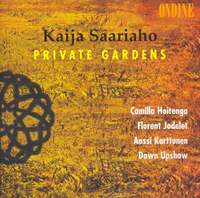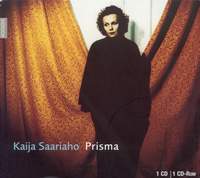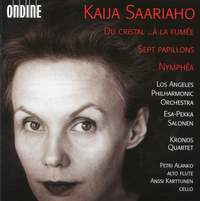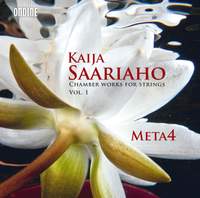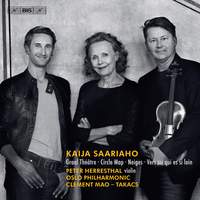Obituary,
Kaija Saariaho (1952-2023)
The Finnish composer Kaija Saariaho has died at the age of 70 in her adoptive home of Paris.
Born in Helsinki in 1952 to a poor family that had fled the Russian takeover of Karelia, Saariaho recently recounted in a lengthy interview with James Jolly for medici.tv how her main early artistic inspirations came not from being surrounded by a household of avid musicians but from the radio and a lifelong interest in poetry – as well as her rural surroundings and the varied soundscapes they created.

Saariaho saw little need to pursue performance herself – despite learning numerous instruments, the idea of a performing career never exerted any pull on her. Her passion was always the imagining of music – the communicating to others of the creation that was going on in her mind. Educated at the Sibelius Academy and Hochschule für Musik Freiburg, Saariaho’s initial musical direction pointed her towards serialism. However, like many of her contemporaries, she came to react against the strictness of that approach; despite attending the Darmstadt Summer Courses on numerous occasions, she emphatically rejected the musical philosophy of the “Darmstadt School” of modernists, such as her teachers Ferneyhough and Huber (and perhaps most notably Boulez, Nono and Stockhausen).
Saariaho later observed of this musical current that “[y]ou were not allowed to have pulse, or tonally oriented harmonies, or melodies. I don’t want to write music through negations. Everything is permissible as long as it’s done in good taste.” The idea of music being more than just an abstract resolution of principles would remain important to her throughout her career.
A turning-point seems to have come in 1980 with Saariaho’s exposure to what would become known – albeit contentiously – as the “spectralist” movement in music. The textures and timbres so beloved by the likes of Gérard Grisey and Tristan Murail evidently offered Saariaho a welcome new direction, and the logical next step – that of including computers in the crafting of her music – soon followed. 1982 saw her move to Paris’s influential IRCAM research institute (where she would also meet her husband Jean-Baptiste Barrière) and embracing the world of electronics, both as an aid to composition and as a component within it. Her Jardin secret triptych from the mid-1980s typifies this period in her work – unashamedly electronic, often otherworldly, soundscapes that relied heavily on the use of synthesisers and whose composition was to a large extent governed by computer programs.
At around the same time, another component of Saariaho’s style was taking shape - her use of huge, slowly-evolving tone-clusters (as in the ocean-like wall of sound that opens her 1982 Verblendungen). This sound – almost merging into what we would today call ambient music – was refined over the ensuing years and became Saariaho’s most recognisable hallmark.
The year 2000 saw the premiere of L’amour de loin, her first opera and something of a musical watershed. Although she had long shied away from the genre, in the early 1990s the stars aligned in such a way as to bring Saariaho, librettist Amin Maalouf and director Peter Sellars together, and the work (inspired by the romantic tale of a twelfth-century troubadour and his admiration from afar for a foreign noblewoman) slowly took shape over almost a decade.
Despite an instinct to stop at one opera (in that conversation with James Jolly, she remarks that on seeing Berg’s Wozzeck and Lulu and much preferring the former, she began to feel that a composer’s first opera was often their best), more soon followed. In the 2000s a loose triptych emerged, focusing on the experiences of women – the uncompromisingly grim Adriana Mater (2005), centred around the upbringing of a child born as a result of a wartime rape; the quasi-oratorio La Passion de Simone (2006), giving a Stations of the Cross-style treatment to the life of the French activist, poet and mystic Simone Weil, whose poetry Saariaho had known from a young age; and Émilie (2008), exploring the multifaceted achievements of Émilie du Châtelet – co-author with her lover Voltaire of a translation of Newton’s treatises on physics, but more importantly one of the first women to establish an independent reputation as a scientist, earning acclaim for her studies on the nature of fire. A final opera in 2018, Innocence (which had its UK premiere only a few weeks ago) showed her again to be unafraid of tackling uncomfortable subjects, with a harrowing and all-too-familiar plot centred around the aftermath of a school shooting.
Indeed the 2010s were no less fruitful than Saariaho's earlier career, with texture-focused orchestral works such as 2012’s Circle Map and 2019’s Vista continuing to draw praise; in reviewing the US premiere of the latter work, the Los Angeles Times aptly described her as “an extraordinary musical colorist”. It’s certainly common for composers to be paid the compliment of being likened to painters – be it impressionists, watercolourists or Cubists – but in Saariaho’s case the comparison is, for once, more than just an idle simile.
Saariaho was diagnosed with glioblastoma in early 2021, and died in Paris on June 2nd 2023. She is survived by her husband Jean-Baptiste Barrière – a composer, multimedia artist and computer scientist – and their two children, Aliisa Niege and Aleksi.
“Everything is permissible as long as it's done in good taste.” – Kaija Saariaho
Image article credit © Andrew Campbell
Kaija Saariaho – a selected discography
Various artists including the Finnish Radio Symphony Orchestra, Hannu Lintu, Sakari Oramo, John Storgårds (violin), Gerald Finley (baritone) and Dawn Upshaw (soprano)
Available Formats: MP3, FLAC
Camilla Hoitenga (flute), Florent Jodelet (percussion), Anssi Karttunen (cello), Dawn Upshaw (soprano)
Available Formats: MP3, FLAC
Artists including Dawn Upshaw (soprano), Camilla Hoitenga (flute), Florent Jodelet (percussion)
Available Formats: MP3, FLAC
Petri Alanko (alto flute), Anssi Karttunen (cello), Los Angeles Philharmonic Orchestra, Kronos Quartet, Esa-Pekka Salonen
Available Formats: CD, MP3, FLAC
Daniel Belcher (Jaufré Rudel), Ekaterina Lekhina (Clémence), Marie-Ange Todorovitch, (Le Pèlerin), Rundfunkchor Berlin & Deutsches Symphonie-Orchester Berlin, Kent Nagano
Available Formats: MP3, FLAC
Kari Kriikku (clarinet), Anu Komsi (soprano), Finnish Radio Symphony Orchestra, Sakari Oramo
Available Formats: CD, MP3, FLAC
Dominique Blanc (narrator), Dawn Upshaw (soprano), Tapiola Chamber Choir, Finnish Radio Symphony Orchestra, Esa-Pekka Salonen
Available Formats: SACD, MP3, FLAC
Minna Pensola (violin), Anna Laakso (piano), Atte Kilpelainen (viola), Marko Myohanen (electronics), Antti Tikkanen (violin), Tomas Djupsjobacka (cello), Kaija Saariaho (electronics), Meta4
Available Formats: CD, MP3, FLAC, Hi-Res FLAC
Peter Herresthal (violin), Oslo Philharmonic Orchestra, Clément Mao-Takacs
Available Formats: SACD, MP3, FLAC, Hi-Res FLAC



